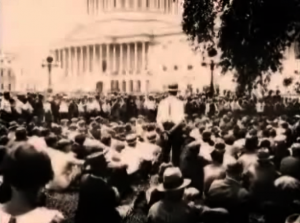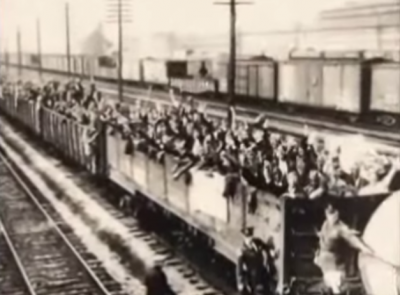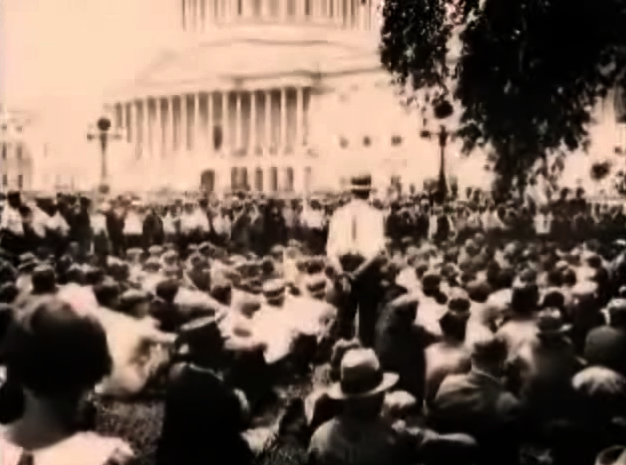 When thinking about how to demand a Green New Deal it is paramount to learn from how the FDR New Deal was won. An important precursor to that victory, and an important event in American history for working people, was the arrival of the “Bonus Army” in Washington DC that occurred 83 years ago today in 1932.
When thinking about how to demand a Green New Deal it is paramount to learn from how the FDR New Deal was won. An important precursor to that victory, and an important event in American history for working people, was the arrival of the “Bonus Army” in Washington DC that occurred 83 years ago today in 1932.
The Bonus Army, as it was known, was comprised of WWI veterans who were seeking the deferred compensation they were owed for their service. WWI was the first war in which the majority of the American army was drafted, and the compulsory nature of the draft recast soldiering as work rather than simply doing one’s duty to God and country.
When the veterans returned, having witnessed everything from gay Paris to the horrors of the trenches, they soon realized their military pay was paltry compared to what those who worked in the homefront factories and other industries received while feeding the US war machine. The veterans effectively agitated for an “adjusted compensation” package for all who served, as governments going back to the Roman republic know it is risky to snub masses of men who have just spent years sacrificing for the nation while practicing violence at the highest levels.
The war “Bonus” (as it was called by critics) was passed in 1924, granting many of the veterans between $800-$1000, depending on how long they served in the war. But the bonus was not scheduled to be paid out until 1945, though a veteran’s family could collect the money if he died before then.
But we know what happened in 1929 – the stock market collapsed and the Great Depression set in. Veterans struggled to find jobs along with everyone else, and a group of unemployed veterans found hope in a bill that was introduced to Congress that would pay out the war bonus immediately. The word spread everywhere and, though it’s hard to imagine now – with long-distance transit being so locked down – throngs of vets were able jump onto railcars and make their way across the nation to Washington DC. Others piled onto cars and trucks, with signs announcing their demands as they made their way.

At its peak, the “Bonus Expeditionary Force” (aka “BEF” or “Bonus Army”) amassed 43,000 people in their encampment (17,000 veterans + their families). The sheriff of DC at the time called the BEF “symbolic of the vast army of the unemployed”, and government officials were afraid this was the beginning of an actual revolution.
And the BEF was revolutionary in some ways. African Americans participated in the Bonus Army movement, integrated with veterans with whom they were not allowed to serve alongside during the actual war. Together, the marchers laid out a tent city on a mud flat across the Anacostia River from the Capitol, with named streets, music, American flags everywhere, symbolic protests and tens of thousands of men, women and children creating their own entertainment and looking after each other. Considering how Occupy Wall Street captured the imagination of the American public and media in 2011, it’s not difficult to imagine how radical collective struggle on such a massive scale won Americans’ sympathy and support.
What was not well-known outside of the encampment at the time, but was considered deeply subversive by officials who were aware, was that African Americans and whites were sharing sleeping quarters, food, chores, recreation and nearly every other manner of social activity. At the height of Jim Crow in a southern US city, the racist power structure considered the example being born out in the camp as even more dangerous than the message of economic populism.
Through some of the most spirited lobbying that Congress has ever seen, the BEF won passage of the Bonus payout in the House of Representatives. But the Senate, bastion of conservatism it was always designed to be, resoundingly defeated the bill. The BEF peacefully dispersed from around the Capitol building after the news was delivered, but the camp remained. President Hoover soon signed an order to evict the remaining +11,000 people in the tent city.
The military, under Douglas MacArthur, had been rearing for a fight and was prepared with tanks, gas and machine guns. Dwight D. Eisenhower was a Major at the time, and participated in the eviction. The brutal rout of veterans, women and children earned Hoover even more scorn from the nation, and was an important opportunity for Franklin D. Roosevelt’s presidential (even though he opposed the Bonus Army’s demands).
When a second Bonus demonstration arose during FDR’s first year in office, he demonstrated savvy by offering them a campsite, three meals a day, and eventually sent First Lady Eleanor Roosevelt to visit. Secret negotiation produced a measure guaranteeing 25,000 spots for veterans in the newly-created Civilian Conservation Corps. That form of public works employment would expand massively under the Works Progress Administration and other New Deal programs beginning in 1935.
Sadly, we would not see the collective racial harmony exemplified by the Bonus Army again until the Civil Rights Movement of the 1960s. But the Bonus Army itself was an inspiration to the legendary black civil rights leader and socialist A. Philip Randolph for the March on Washington Movement he led in the 1940s. The very threat of that march on the Capitol was enough to get FDR to concede to the movement’s demand for an executive order to desegregate all national defense industries.
In fact, what’s commonly known as the March on Washington of 1963 (over thirty years after the Bonus Army’s arrival) was actually promoted as the “March on Washington for Jobs and Freedom.” While mainly remembered for Martin Luther King, Jr’s “I Have a Dream” speech and the ensuing voting rights victories for African Americans, that march also carried Randolph’s vision for economic justice through a raise in the minimum wage (which the current Federal minimum wage does not meet, when accounting for inflation) and more fair labor standards.
It’s perhaps because the Bonus Army was so radical and inspiring to Americans engaged in collective struggle at the time that it is rarely mentioned except in dry, textbook descriptions. While we don’t have a Hollywood dramatization starring George Clooney or Brad Pitt, we do have an affecting PBS documentary narrated by Gary Sinese, which can be seen below.
Remember the Bonus Army and, spread the word!
